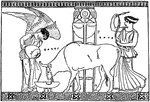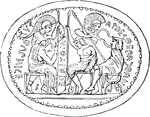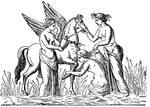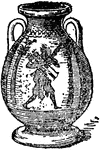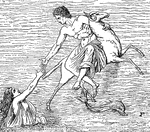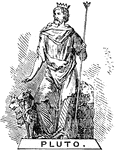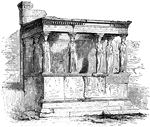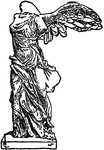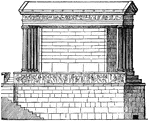
Temple of Nike Apteros
"The first public monuments that arose after the Persian wars were erected under the auspices of Cimon,…
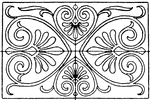
Greek Oblong Panel
The Greek oblong panel has a strict palmette decoration. It is found in the painted coffers (sunken…
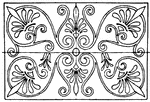
Greek Oblong Panel
The Greek oblong panel has a strict palmette decoration. It is found in the painted coffers (sunken…
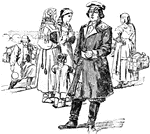
People of Odessa
"Odessa is the chief city of southern Russia, and men from all the countries about come here to trade."…
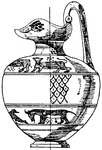
Greek Oinochoe
This Greek Oinochoe has an Asiatic style that is painted in yellow clay. It was used as a sacrificial…
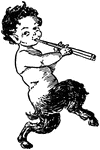
Pan
Pan in Greek religion and mythology, is the companion of the nymphs, god of shepherds and flocks, of…
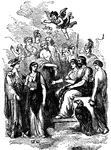
Pandora
"Epimetheus had in his house a jar in which were kept certain noxious articles, for which, in fitting…

Parthenon restored
"The Parthenon stood on this highest part of the Acropolis, near its centre, and probably occupied the…
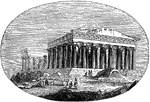
Modern Parthenon
"The Athenians, on their return to Attica, after the defeat of the Persians, found their city ruined…
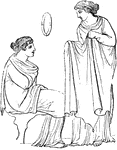
Peplus
"The peplus was a shawl which commonly formed part of the dress of females. It was often fastened…

Pericles
"So long as Pericles stood at the head of Athens in time of peace, he governed it with moderation and…

Bust of Pericles
"The enormous influence which Pericles exercised for so long a period over an ingenious but fickle people…

Phaethon
"Then Phaethon beheld the world on fire, and felt the heat intolerable. The air he breathed was like…
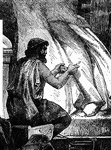
Phidias in His Study
"Phidias was the chief glory of the administration of Pericles. To him was committed the work of making…

Statue of Phocion
"A more graceful mode of wearing the palla was to attach it by means of a brooch, and allow…
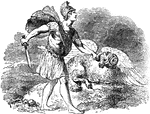
Phryxsus and ram
"When Phryxsus arrived in Colchis, he sacrificed his winger ram to Jupiter, in acknowledgement of the…
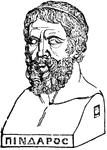
Bust of Pindar
"Pindar, though the contemporary of Simonides, was considerably his junior. He was born either at, or…
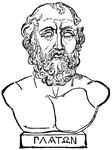
Bust of Plato
"Plato was born in Athens in 429 B.C., the year in which Pericles died. His first literary attempts…

Bust of Plato
Plato was a Classical Greek philosopher, mathematician, writer of philosophical dialogues, and founder…
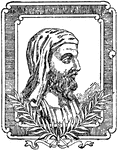
Plutarch
"Plutarch, as the great interpreter of Greece and Rome, exerted on generations succeeding him in influence…

Pluto, Persephone, and Mercury
"Mercury was sent, accompanied by Spring, to demand Persephone of Pluto. The wily monarch consented,…

Pnyx
"Shows the bema, or platform, from which orators addressed the assembled citizens."—Webster, 1913

Polyphemus
"Theocritus asserts that there is no rememdy for Love but the Muses. He then gives an account of the…
Greek Prochous
This Greek Prochous has a geometrical style made out of red clay and painted in black. It was used as…

Greek Prochous
This Greek Prochous is in an archaic form and ornamentation, painted in clay. It was used as a sacrificial…

Propylea restored
"A. Pinacotheca, B. Temple of Nike Apteros, C. Pedestal of Agrippa, D. Road leading to the central entrace,…

Ptolemy in Profile
He was a mathematician, geographer, astronomer, and astrologer. "The name of a line Graeco-Egyptain…
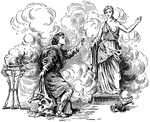
Pygmalion
"The story of Pygmalion and his statue is in all probability an allegory. Pygmalion was a virtuous and…

Colossus at Rhodes
Statue of the Greek god Helios. It is currently considered to be one of the Seven Wonders of the Ancient…
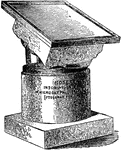
Rosetta Stone
"Rosetta Stone is the name given to a stone found near the Rosetta mouth of the Nile by a French engineer…

Portion of Rosetta Stone
"In the Nile valley there had been found a few ancient inscriptions, carved upon stone in unknown characters,…

Greek Hydria Rosette Band
The Greek hydria rosette band is a design of the neck of a Greek hydria flower.

Greek Rowers
Rower in an Athenian warship, about 400 B.C. (fragment of relief found on the Acropolis).

Scythians on a Greek Vase
Two Scythians are kneeling and resting. This is one of the few existing representations of the ancient…

Scythians on a Greek Vase
Two Scythians tying a rope. This is one of the few existing representations of the ancient Scythians.…

Theater of Segesta
One of the first Greek amphitheaters, located in the political center of the Elymian people.

